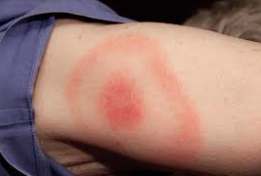Rules, rules, rules.
Posted By Cliff Tuttle | March 4, 2018
No. 1,434
I just heard a doctor on the radio who contracted Lymes Disease and after being wheelchair bound and in excruciating pain for a year and a half, effected a cure, partly through experimenting with herbal medicines. He says that we have a Lymes pandemic in semi rural locations in Western Pennsylvania and that we can reduce risk by following certain rules when communing with nature between April and November.
- Don’t wear shorts;
- Wear white shoes, socks, clothes and hat;
- Wear long sleeves;
- Tuck your pants legs into your socks;
- Spray yourself with Deet or some equivalent.
Maybe this is good advice for walking in the woods, but otherwise not very practical. I’ve known a couple of people who contracted Lymes Disease, probably in an environment no wilder than their back yard.
If you are concerned about Lymes Disease, it is probably a good idea to give up gardening, lawn cutting and not own any furry pets.
Then, since the flu is raging at the moment, avoid movie theaters, church, public restaurants, meetings, shaking hands or kissing anyone and carry a supply of those alcohol wipes everywhere you go.
Of course, automobile accidents are a common source of serious injury and death. So it would be a good idea not to drive unnecessarily. Sunny dry days would be best. Avoid dark nights, heavy rain, snow, rush hours and bad intersections. When driving, change lanes as little as possible. Stay out of the left hand lane, too. Don’t eat, use the phone, change the radio station — driving in silence is better yet. Don’t think about anything but what’s ahead on the road, your destination and how you intend to get there. Of course, don’t drink alcohol or have a large meal before you leave, or anytime for that matter. And don’t forget to always get a good night’s sleep.
I could go on. Every one of the above rules, which we have all acknowledged from time to time, will reduce our risk of disease, injury and early death. The problem is, of course, if we observe all of the practices that will make us safe, we automatically circumscribe a lot of other choices. So, I guess I’ll just have to allow a reasonable risk of Lymes Disease, flu, car accidents and other bad things to occur. In making those choices, I promise not to engage in “if only” recriminations after bad things happen.
The truth is, bad things are often not foreseeable or preventable. Once, while walking in back of the Allegheny County Court House on a cold January day, my view was suddenly obstructed, followed by a loud explosion at my feet. Looking down, my feet were covered by a mound of crushed ice. A large ice- cycle had fallen off the building, one step in front of me. If I had taken one more step before it happened, I would probably have been dead or seriously injured.
At the far end of the probability curve are so-called “black swan events.” The philosopher David Hume speculated about the possibility that there might be black swans in the world, even though no one he knew had ever seen one. In fact, it was later discovered that black swans existed in Australia. A black swan was described by writer Nasim Taleb as an event so rare that it is unpredictable. Great historic events, such as the rise of Napoleon, are often described that way. In hindsight, people often claim that such an event could have been predicted with enough information. But I doubt it.
Then, in the same genre, there is “butterfly effect”. The term arises from the idea that a butterfly flapping its wings might, through a chain of unpredictable events, cause a monsoon. A well-known example: for the lack of nail . . . the kingdom was lost. This is to be distinguished from “butterfly events” which involve the release of a large number of butterflies at weddings and the like.
And when its all over, despite all of the precautions we may or may not make, its wonderful to be lucky.
Have a lucky day!
CLT




